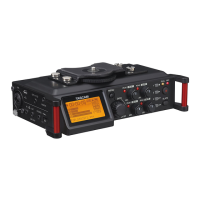
Do you have a question about the Tascam DR-70D and is the answer not in the manual?
| Signal-to-Noise Ratio (SNR) | 92 dB |
|---|---|
| XLR in | Yes |
| USB 2.0 ports quantity | 1 |
| Minimum RAM | 64 MB |
| Compatible operating systems | Windows XP, Windows Vista, Windows 7, Windows 8, Windows 8.1, Mac OS X Jaguar (V10.2), Mac OS X Panther (V10.3), Mac OS X Tiger (V10.4), Mac OS X Leopard (V10.5), Mac OS X Snow Leopard(V10.6.8), OS X Lion(V10.7), OS X Mountain Lion(V10.8), OS X Mavericks(10.9) |
| Microphone maximum input | 0 |
| Audio quality | 16 bit |
| Frequency range | 20 - 20000 Hz |
| Weight | 625 g |
|---|---|
| Dimensions (WxDxH) | 169 x 55.2 x 106.5 mm |
Introduces the recorder's features and explains manual conventions.
Details compatible SD cards, usage, and safety guidelines.
Identifies and describes controls and connectors on the unit's front, rear, side, top, and bottom panels.
Explains the layout and indicators on the Home and Recording screens.
Overview of menu structure, navigation, and performing basic operations.
Explains powering options: batteries, AC adapter, USB, and their usage.
Instructions for turning on/off, resume, setting date/time.
Steps for inserting, removing, formatting, and protecting SD cards.
Connecting monitoring equipment, cameras, and setting up microphones/LINE IN.
Selecting file formats, recording channels, and adjusting stereo pan.
Detailed guide to setting input gain, sources, and plug-in power.
Configuring phantom power, limiter, and low-cut filter functions.
Adjusting mic distances, phase, and setting file type, format, sampling frequency.
Details on MONO, STEREO, 2MIX recording and creating new tracks.
Enabling and using dual recording for simultaneous files with different levels.
Using tone functions, slate tones, and mid-side microphone recording.
Table showing maximum recording times based on card capacity and format.
Understanding the BROWSE screen layout, file navigation, and icons.
Performing actions on files (info, delete) and managing folders (select, create).
Starting, pausing, stopping, searching, and selecting files for playback.
How to play back files created using the dual recording feature.
Methods for transferring files and safely disconnecting the unit from a computer.
Accessing details on loaded files, SD card status, and system settings.
Steps for formatting SD cards and configuring system parameters.
Configuring battery type and customizing file naming conventions.
Connecting and configuring the RC-3F footswitch for remote control.
Connecting and using the RC-10 wired remote control.
Interpreting and responding to messages related to power, SD cards, and files.
Understanding error messages for system settings, input configuration, and general failures.
Resolving problems with unit power, functionality, and SD card recognition.
Troubleshooting distorted sound, recording failures, and file display problems.
Details on supported media, file formats, and channel configurations.
Technical specifications for audio ports, frequency response, distortion, and S/N ratio.
Specifications for USB/REMOTE ports and equivalent input noise.
System requirements for computers used with the TASCAM DR-70D.
Information on power sources and estimated battery life under various conditions.
Details on the recorder's physical size, weight, and operating temperature.
Illustrations showing the physical dimensions of the unit.